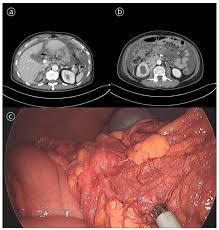
 Peritoneal metastases refer to the spread of malignant cells to the peritoneal surface from a primary tumor located elsewhere in the body.
Peritoneal metastases refer to the spread of malignant cells to the peritoneal surface from a primary tumor located elsewhere in the body.
Peritoneal metastases is commonly associated with gastrointestinal and gynecological malignancies, such as colorectal, gastric, ovarian, and pancreatic cancers.
The peritoneum is a mesothelial lining of the abdominal cavity, and provides a conducive environment for metastatic spread due to its extensive surface area and fluid dynamics that facilitate the dissemination of cancer cells.
The pathogenesis of peritoneal metastases: shedding of cancer cells from the primary tumor, survival in the peritoneal cavity, adhesion to the peritoneal surface, and subsequent invasion and proliferation within the submesothelial space.
Metastatic cells can spread via direct invasion, lymphatic permeation, peritoneal seeding, or hematogenous routes.
Clinical presentation of peritoneal metastases includes: symptoms abdominal pain, distension due to ascites, and bowel obstruction.
Diagnosis typically involves imaging modalities -CT scans and MRI, US and sometimes requires surgical exploration for confirmation.
Treatment options include systemic chemotherapy, cytoreductive surgery, and hyperthermic intraperitoneal chemotherapy (HIPEC).
The efficacy of these treatments can vary based on the primary tumor type and the extent of metastatic spread.
The efficacy of checkpoint inhibitors with peritoneal metastatic colorectal with microsatellite instability is less than with liver metastases.
